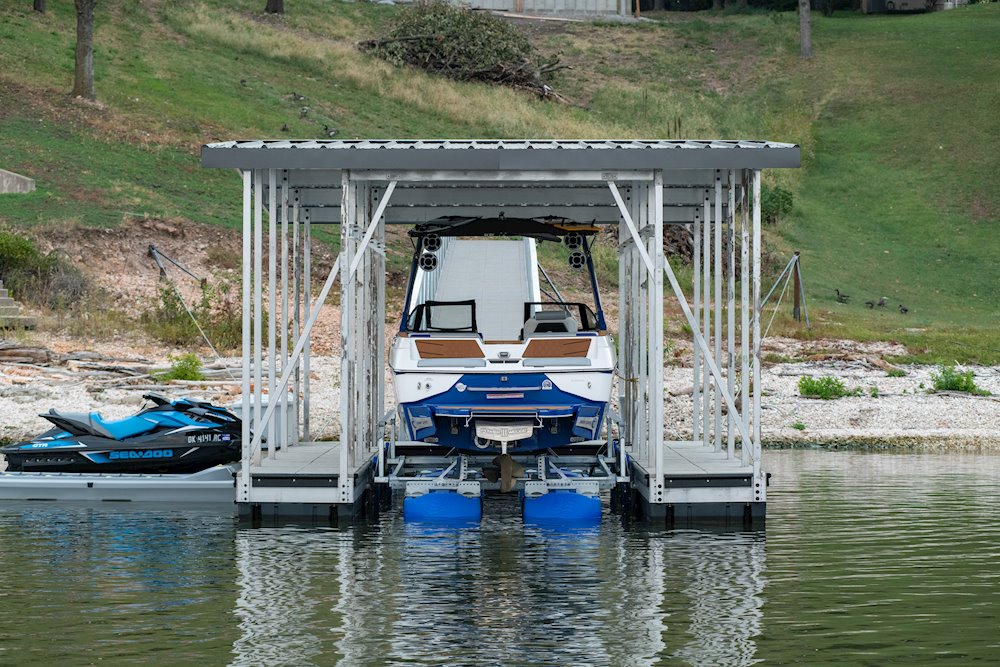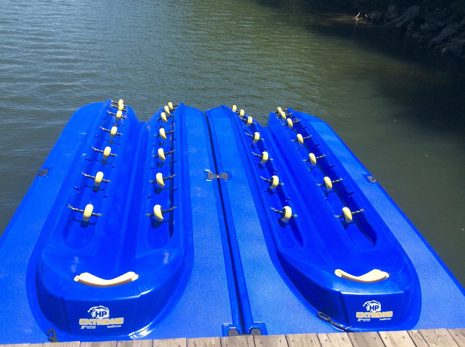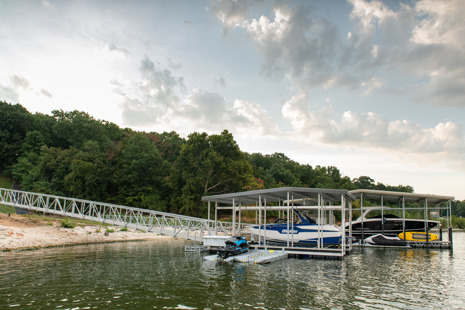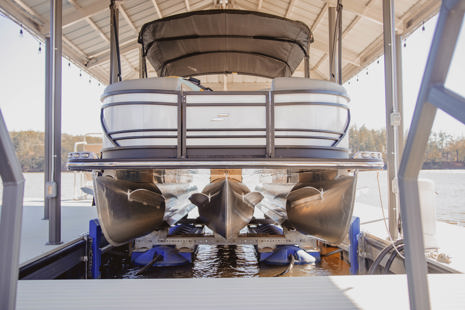Top Benefits of Using a Boat Lift
Key Takeaways
When left sitting in the water, hulls quickly accumulate slime, scum, algae, and other marine growth, which dulls finishes and accelerates wear.
With a premium boat lift, a simple push of a button is all it takes. Your boat can be in the water and ready to go in minutes.
While boat lifts require a considerable upfront investment, they effectively pay for themselves over time by minimizing costly maintenance and preserving your boat’s long-term value.

Leaving your boat in the water for extended periods might seem convenient, but it comes with hidden costs. From hull damage caused by algae and barnacles to inevitable impacts from wave action, tidal shifts, and floating debris, wet storage slowly takes its toll on your vessel’s aesthetics, performance, and value. That’s why discerning boaters invest in quality boat lift systems to safeguard their investments and make their boating lifestyle easier and more enjoyable.
Below, we’ll cover the litany of benefits a boat lift offers and walk you through the primary features, accessories, and considerations to help you choose the optimal storage solution for your vessel.
Protection and Preservation of Your Boat
Constant exposure to the elements when not in use subjects boats to risks and maintenance challenges you could otherwise avoid by storing your vessel above the waterline.
Hull Damage Prevention
When left sitting in the water, hulls quickly accumulate slime, scum, algae, and other marine growth, which dulls finishes and accelerates wear. Aluminum hulls are especially prone to staining, while fiberglass boats, despite their glossy gelcoat, are porous and susceptible to buildup and discoloration. Even high-quality hull coatings can’t fully protect against the impact of standing water.
In saltwater environments, corrosion poses an even greater threat, steadily degrading metal components below the waterline. Combined with constant UV exposure, this can erode protective coatings and finishes, diminishing both performance and appearance. A boat lift mitigates these risks by keeping the hull dry, preventing damage before it occurs.
Reduced Wear & Tear
A moored boat is vulnerable to waves, currents, and high winds that can push it against the dock or shore. Even small movements can cause friction against bumpers and pilings, wearing down paint and finishes. And that’s before factoring in traffic. According to the U.S. Coast Guard’s 2023 Recreational Boating Statistics report, collisions with other vessels and fixed objects are among the most frequent types of boating accidents, especially during docking and maneuvering in confined areas (USCG, 2024).
When a boat is in the water, rain and small leaks inevitably require the bilge pump to work overtime to keep the vessel from taking on water. Storing the boat on a lift significantly reduces the bilge pump’s workload, preserving its lifespan and your boat’s battery.
Safety Benefits
A boat lift doesn’t just protect your vessel – it also creates a safer environment for your dock and everyone who uses it.
Safety for Your Vessel
Storms, high winds, or even just passing boat wakes can cause it to collide with the dock or other objects. In severe weather, lines can break, leading to catastrophic damage or the complete loss of your boat. Even a minor incident can cause thousands of dollars in repairs. While no boat lift system can fully shield a vessel from the fury of extreme weather, a boat lift offers significantly greater protection from collision-related damage than leaving your boat moored.
Safety for Dock & Infrastructure
Dock structures take a beating when boats shift against them in choppy water. Even during calmer conditions, the repetitive push and pull of mooring lines exert constant stress on the dock system. Over time, this weakens pilings, cleats, and frames. A lift eliminates this strain on your dock system, extending the integrity and longevity of your entire waterfront infrastructure.
Personal Safety
Boarding a boat that is moving in the water can be a precarious activity, especially for children, pets, or anyone with mobility challenges. A boat lift provides a stationary, stable platform that is level with the dock. This minimizes the gap and the unstable movement, making it significantly easier and safer to load gear and for everyone to get on and off the boat without the risk of slips, falls, or missteps.
Convenience & Lifestyle Improvements
One of the biggest advantages of a boat lift is how it simplifies the boating experience
Quick, Convenient Access: Forget the time-consuming process of trailering your boat, waiting in long lines at the public ramp, and maneuvering it into the water. With a premium boat lift, a simple push of a button is all it takes. Your boat can be in the water and ready to go in minutes.
Easier Cleaning and Maintenance: With the entire hull out of the water, cleaning and maintenance become exponentially simpler. You can easily access the bottom for scrubbing, inspect the propeller, and perform routine checks without needing to haul the boat out or get in the water.
Less Hassle, More Boating: The ease of launching and docking means you’re more likely to use your boat for spontaneous evening cruises or quick fishing trips. In addition to removing the biggest barriers to frequent use, a boat lift also eliminates the guesswork from tying off or adjusting lines during fluctuating water conditions.
Overall, investing in a boat lift transforms the entire ownership experience, making boating simpler, safer, and far more enjoyable.
Financial Benefits
While boat lifts require a considerable upfront investment, they effectively pay for themselves over time by minimizing costly maintenance and preserving your boat’s long-term value.
Lower Maintenance Costs
Professional hull cleaning can cost anywhere from $10 to $40 per foot (TrickyFish, 2025). This means that if you have a 25-footer, you could be spending $1,000 on standard cleaning services that don’t include additional services or repairs like bottom paint or gel coat restoration. By keeping the hull dry, a lift reduces the need for these services and other repair expenses associated with prolonged water exposure.
Improved Performance & Fuel Efficiency
A clean hull is a fast and efficient hull. Marine growth creates significant drag, which forces your engine to work harder, burn more fuel, and reduces your boat’s overall performance and top speed. According to a 2024 report from the International Maritime Organization, hull fouling can increase fuel consumption by up to 40% – a costly consequence that underscores the importance of proactive hull maintenance (IMO, 2022).
Resale Value Preservation
A boat that’s stored on a lift will almost certainly command a higher resale price. Prospective buyers can immediately see the difference between a well-maintained hull versus one that has spent most of its life in the water. The superior condition, both cosmetic and mechanical, signals that the vessel has been well-cared for, making it a far more attractive investment.
Features & Accessories to Consider
Depending on your unique needs and boating lifestyle, the perfect combination of features and accessories can turn a simple dry-docking solution into the ultimate boating upgrade. Here are some boat lift features and accessories to consider:
Canopy Systems: Adding a canopy frame and cover to your boat lift system provides comprehensive protection against UV rays, rain, and moisture – preserving your vessel’s upholstery, paint, and finish. A well-designed canopy system also enhances the visual appeal of your dock, creating a cohesive and elevated waterfront aesthetic.
Lift Controls: Premium lifts feature push-button or remote-controlled operation, with some even allowing you to operate your lift from a smartphone app. You can lower your boat into the water as you walk down the dock, taking boating convenience to another level.
Accessories: Safety enhancements, such as bow guides, bumpers, and fenders, make it easier and safer to position your boat on the lift, even in less-than-ideal conditions. They help center your boat on the lift and protect your vessel from scratches and impacts during docking and launching transitions.
When chosen wisely, these features not only protect your investments but also streamline your boating experience, transforming every launch into a smoother, safer, and more enjoyable adventure.
Choosing the Right Boat Lift
The optimal boat lift system will largely depend on your vessel, waterfront conditions, and installation constraints. Here’s an overview of the primary considerations:
Lifting Capacity: Ensure the lift can support the wet weight of your fully loaded boat, including all the gear and equipment stored onboard. A good rule of thumb is to choose a system capable of lifting 20-25% more than your boat’s wet weight to avoid overloading the lift and risking mechanical failure and potential damage.
Waterfront Conditions: Water depth, tidal fluctuations, bottom composition, and wave activity all influence the type of lift that will perform best in your environment. For example, areas with shallow or fluctuating water may call for a floating lift or cantilever system, while rougher conditions might require a more robust, four-post configuration for added stability.
Features and Customization: Remote control operation, solar-powered motors, guide-ons, and canopy systems can significantly increase the overall cost of a boat lift. While these upgrades exponentially enhance convenience and protection, we recommend assessing which features are essential for your boating lifestyle to get optimal value for money.
Before shopping for a lift, check the local zoning laws, permitting requirements, and environmental regulations that govern waterfront construction in your area to avoid costly violations. costly violations. In most cases, an authorized boat lift dealer should be able to assist in navigating these regulatory requirements.
FAQ Section
How often should I lift the boat vs let it float?
We recommend lifting the boat whenever it’s not in active use. Even a few days in the water lead to slime growth and expose it to impact damage.
Do boat lifts work in freezing climates?
Yes, but winterization is key. Some lifts are designed to be removed seasonally, while others can remain in place with ice-protection systems. Always consult your dealer for regional best practices.
What maintenance is required for the lift itself?
While boat lift maintenance requirements will depend on the lifting mechanism, routine tasks generally include regularly rinsing the lift components with fresh water to remove dirt, algae, and other debris, and lubricating moving parts according to the manufacturer’s recommendations to ensure smooth operation and minimize wear and tear. You can browse our boat lift installation instructions for more information.
Is lift ownership cheaper than storing in marina slips?
In many cases, yes. Annual slip fees add up quickly, while a lift is a one-time investment that saves money on hull cleaning, repairs, and storage over the long term.
Conclusion
Boat protection, secure storage, streamlined launching and docking – ask anyone with a boat lift and you’d be hard-pressed to find anyone who would ever go back to wet storage. Explore some of the best boat lifts for sale today. Use the dealer locator tool below to get a list of authorized HydroHoist dealers near you and give your boat the protection it deserves.
References:
United States Coast Guard (May 28, 2024). Coast Guard releases 2023 recreational boating statistics
TrickyFish (May 14, 2025). How Much Does It Cost to Clean a Boat Hull?
International Maritime Organization (2022). Analysing the Impact of Marine Biofouling on the Energy Efficiency of Ships and the GHG Abatement Potential of Biofouling Management Measures



